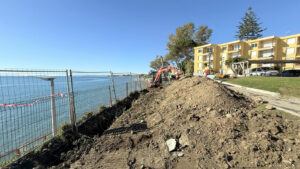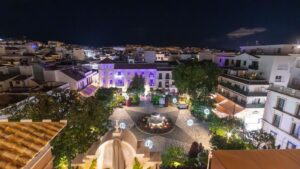Estepona’s Architectural Marvels
Nestled along the sun-kissed shores of Costa del Sol, Estepona is not just a haven for beach lovers and gastronomy enthusiasts. This charming coastal town is also a treasure trove of architectural wonders that span centuries, offering a unique journey through time and design. From ancient Moorish structures to cutting-edge modern buildings, Estepona’s architecture tells a fascinating story of cultural influences, historical events, and contemporary innovation.
A Walk Through Estepona’s Architectural History
Estepona’s architectural landscape is a testament to its rich history and diverse cultural influences. As you wander through the town’s winding streets, you’ll encounter a captivating blend of styles that reflect different periods of Spanish and Mediterranean history.
The Old Town is the heart of Estepona’s historical architecture. Here, whitewashed houses with colorful flower pots adorning their facades create a picturesque scene that epitomizes traditional Andalusian charm. The narrow, cobblestone streets lead to hidden plazas and centuries-old churches, each with its own unique architectural features.
One of the most notable historical structures is the Clock Tower (Torre del Reloj), a remnant of the 15th-century San Luis Castle. This tower, with its distinctive bell and clock face, stands as a proud symbol of Estepona’s past and serves as a focal point for the town’s historical center.
Not far from the Old Town, you’ll find the Church of Our Lady of Los Remedios, a beautiful example of 18th-century religious architecture. Its ornate baroque façade and intricate interior decorations showcase the craftsmanship of the era and the importance of religious buildings in Spanish urban design.
Modern Marvels: Estepona’s Contemporary Architecture
While Estepona cherishes its historical buildings, it has also embraced modern architecture with enthusiasm. The town’s skyline is punctuated by sleek, contemporary structures that harmoniously coexist with their older counterparts.
One of the most striking examples of modern architecture in Estepona is the Orchidarium. This innovative glasshouse, home to one of the largest collections of orchids in Europe, is a marvel of sustainable design. Its unique structure, reminiscent of a giant glass teardrop, houses not only beautiful flowers but also serves as a testament to Estepona’s commitment to blending nature with cutting-edge architecture.
Another modern architectural gem is the Estepona Athletics Stadium. This state-of-the-art sports facility showcases how functional design can also be aesthetically pleasing. The stadium’s sweeping lines and innovative use of materials make it a landmark of contemporary Spanish architecture.
For those interested in modern residential architecture, a stroll along Estepona’s beachfront reveals a series of luxurious apartment complexes that combine Mediterranean aesthetics with modern comforts. These buildings, with their clean lines, large windows, and spacious balconies, offer a glimpse into the future of coastal living on the Costa del Sol.
Bridging the Gap: Estepona’s Architectural Fusion
What truly sets Estepona apart is its ability to seamlessly blend old and new architectural styles. This fusion is perhaps best exemplified in the town’s ongoing urban renewal projects, which aim to preserve historical structures while integrating modern elements.
The Plaza de las Flores, for instance, is a perfect example of this blend. This vibrant square, surrounded by traditional Andalusian buildings, has been revitalized with modern landscaping and urban furniture, creating a space that honors the past while embracing the present.
Similarly, the Estepona Marina showcases how modern maritime architecture can complement the town’s traditional coastal aesthetics. The marina’s sleek design and state-of-the-art facilities provide a contemporary contrast to the nearby fishing port, highlighting Estepona’s evolution from a small fishing village to a modern coastal destination.
For art enthusiasts, Estepona’s vibrant art scene has also left its mark on the town’s architecture. The Ruta de Murales Artísticos (Artistic Mural Route) has transformed many building facades into stunning works of art, adding a unique dimension to Estepona’s architectural landscape.
Sustainable Architecture: Estepona’s Green Future
As Estepona continues to grow and evolve, there’s an increasing focus on sustainable architecture. New developments in the town are incorporating eco-friendly design principles, from energy-efficient buildings to green spaces that enhance urban biodiversity.
The Estepona Environmental Education Center is a prime example of this commitment to sustainability. This innovative building, designed to minimize its environmental impact, serves as both an educational facility and a model for future green architecture in the region.
Estepona’s dedication to sustainable urban development extends beyond individual buildings. The town has invested in creating more pedestrian-friendly areas, expanding green spaces, and improving public transportation infrastructure. These initiatives not only enhance the quality of life for residents and visitors but also contribute to a more sustainable urban environment.
Experiencing Estepona’s Architectural Diversity
For visitors eager to explore Estepona’s architectural wonders, the town offers several guided tours that highlight its diverse building styles and urban design. These tours provide insights into the history and significance of various structures, from ancient watchtowers to modern civic buildings.
Architecture enthusiasts can also enjoy events like the annual Estepona Architecture Week, which features exhibitions, lectures, and workshops celebrating both local and international architectural achievements.
For a unique perspective on Estepona’s architectural landscape, consider taking a boat tour along the coast. This vantage point offers stunning views of the town’s skyline, showcasing how the various architectural styles come together to create Estepona’s distinctive coastal silhouette.
As you explore Estepona’s architectural marvels, don’t forget to take time to enjoy the town’s other attractions. From its beautiful beaches to its delicious cuisine, Estepona offers a wealth of experiences that complement its rich architectural heritage.
Conclusion: A Living Museum of Architecture
Estepona’s architectural landscape is a living museum that tells the story of this coastal gem’s evolution through the ages. From ancient Moorish influences to cutting-edge sustainable design, the town’s buildings and urban spaces offer a fascinating journey through time and style.
As Estepona continues to grow and develop, it remains committed to preserving its architectural heritage while embracing innovation. This delicate balance between old and new, tradition and progress, is what makes Estepona’s architecture truly special.
Whether you’re an architecture enthusiast, a history buff, or simply someone who appreciates beautiful surroundings, Estepona’s architectural marvels are sure to captivate and inspire. As you walk its streets and explore its buildings, you’ll discover that in Estepona, every corner tells a story, and every structure is a piece of art waiting to be admired.






